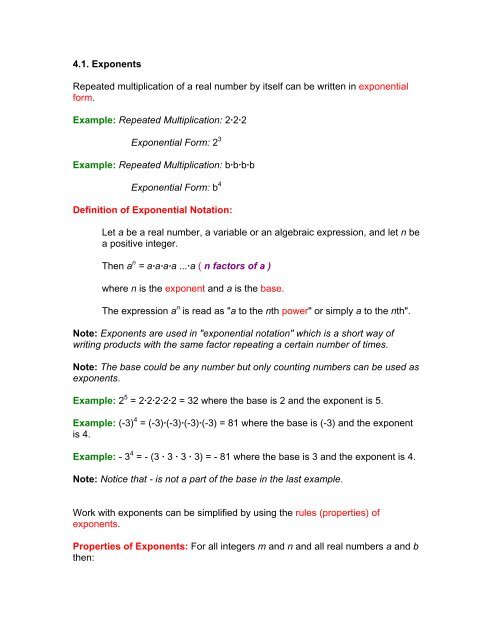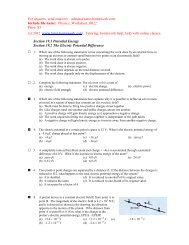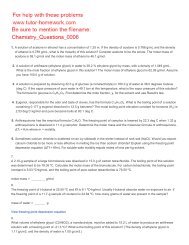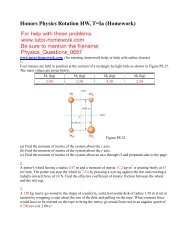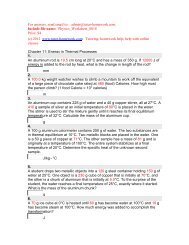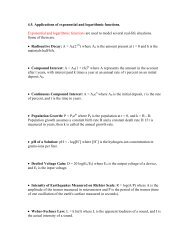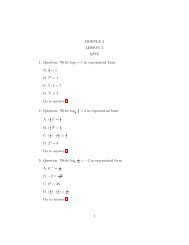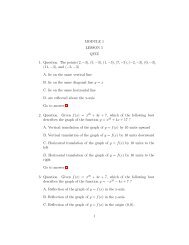4.1. Exponents - Tutor-Homework.com
4.1. Exponents - Tutor-Homework.com
4.1. Exponents - Tutor-Homework.com
You also want an ePaper? Increase the reach of your titles
YUMPU automatically turns print PDFs into web optimized ePapers that Google loves.
<strong>4.1.</strong> <strong>Exponents</strong><br />
Repeated multiplication of a real number by itself can be written in exponential<br />
form.<br />
Example: Repeated Multiplication: 2·2·2<br />
Exponential Form: 2 3<br />
Example: Repeated Multiplication: b·b·b·b<br />
Exponential Form: b 4<br />
Definition of Exponential Notation:<br />
Let a be a real number, a variable or an algebraic expression, and let n be<br />
a positive integer.<br />
Then a n = a·a·a·a ...·a ( n factors of a )<br />
where n is the exponent and a is the base.<br />
The expression a n is read as "a to the nth power" or simply a to the nth".<br />
Note: <strong>Exponents</strong> are used in "exponential notation" which is a short way of<br />
writing products with the same factor repeating a certain number of times.<br />
Note: The base could be any number but only counting numbers can be used as<br />
exponents.<br />
Example: 2 5 = 2·2·2·2·2 = 32 where the base is 2 and the exponent is 5.<br />
Example: (-3) 4 = (-3)·(-3)·(-3)·(-3) = 81 where the base is (-3) and the exponent<br />
is 4.<br />
Example: - 3 4 = - (3 · 3 · 3 · 3) = - 81 where the base is 3 and the exponent is 4.<br />
Note: Notice that - is not a part of the base in the last example.<br />
Work with exponents can be simplified by using the rules (properties) of<br />
exponents.<br />
Properties of <strong>Exponents</strong>: For all integers m and n and all real numbers a and b<br />
then:
1) Product Rule: a m· a n = a m+n<br />
Example: y 4 · y 7 = y 4+7 = y 11<br />
Note: The products of exponential expressions with the same base are found by<br />
adding exponents.<br />
2) Quotient Rule:<br />
Example:<br />
provided a ≠ 0 (since division by zero is undefined).<br />
Example:<br />
provided x ≠ 0.<br />
provided x ≠ 0.<br />
Note: The quotients of exponential expressions are found by subtracting lesser exponent<br />
from greater exponent.<br />
3) Zero Exponent: a 0 = 1 provided a ≠ 0.<br />
Example: 2 0 = 1 or b 0 = 1 provided b ≠ 0.<br />
Note: Any exponential expression raised to the zero power is one. The symbol 0 0 is<br />
undefined.<br />
4) Negative Exponent:<br />
Example:<br />
provided a ≠ 0.<br />
Note: Negative exponents lead to reciprocals.
5) Power Rules:<br />
provided b ≠ 0.<br />
Examples:<br />
Note: In order to remove parentheses a product of exponents must occur.<br />
Example:<br />
6) Special Rules:<br />
Examples:<br />
provided a, b ≠ 0.
Note: Negative exponents are being removed first followed by parentheses.<br />
So far you have dealt with only algebraic functions, which included polynomial and<br />
rational functions. You will now study one type of nonalgebraic function called an<br />
exponential function.<br />
Definition of Exponential Function:<br />
The exponential function f with base a is denoted by f(x) = a x where a > 0, a ≠ 1,<br />
and x is any real number.<br />
Example: f(x) = 2 x is an exponential function because a = 2 which verifies a > 0 and a ≠<br />
1.<br />
Note: a is the base and the base must be a positive real number with the exception of the<br />
number one.<br />
Example: f(x) = x 2 is not an exponential function because the base must be a specified<br />
positive real number with the exception of one. This is an example of an algebraic<br />
function.<br />
Note: The base a = 1 is excluded because it yields f(x) = 1 x = 1. This is a constant<br />
function, not an exponential function.


